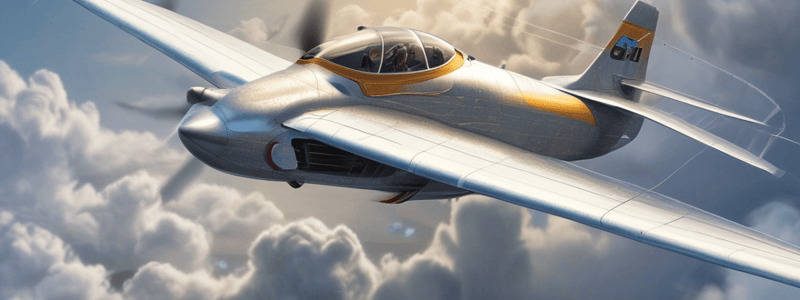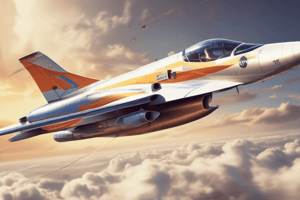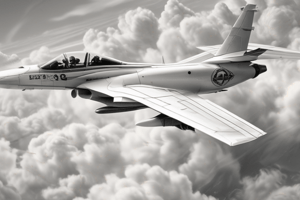Podcast
Questions and Answers
What is the primary factor that affects the performance of an aircraft?
What is the primary factor that affects the performance of an aircraft?
- Air Density
- Pressure Altitude (correct)
- Temperature
- Humidity
What is the effect of warm air on air density?
What is the effect of warm air on air density?
- It becomes denser
- It has no effect
- It remains the same
- It becomes less dense (correct)
What is the result of decreased air density on aircraft performance?
What is the result of decreased air density on aircraft performance?
- Increased lift and engine power
- Increased rate of climb
- No effect on aircraft performance
- Decreased lift and engine power (correct)
What is the correlation between pressure altitude and air density?
What is the correlation between pressure altitude and air density?
What is the purpose of aircraft performance charts?
What is the purpose of aircraft performance charts?
What is the effect of increased humidity on air density?
What is the effect of increased humidity on air density?
What is the result of lower air density on aircraft performance during takeoff and landing?
What is the result of lower air density on aircraft performance during takeoff and landing?
What is the formula used to calculate pressure altitude when an altimeter is not available?
What is the formula used to calculate pressure altitude when an altimeter is not available?
What is the relationship between air pressure and air density?
What is the relationship between air pressure and air density?
What is the rule of thumb used to estimate the effect of pressure changes on altitude?
What is the rule of thumb used to estimate the effect of pressure changes on altitude?
A decrease in air pressure of 1 inch of mercury results in an altitude change of approximately 500 feet.
A decrease in air pressure of 1 inch of mercury results in an altitude change of approximately 500 feet.
Cool air is less dense than warm air.
Cool air is less dense than warm air.
The performance of an aircraft is not affected by changes in temperature.
The performance of an aircraft is not affected by changes in temperature.
Humidity has a more significant impact on air density than pressure and temperature.
Humidity has a more significant impact on air density than pressure and temperature.
The formula for calculating pressure altitude is based on the difference between actual and standard temperature.
The formula for calculating pressure altitude is based on the difference between actual and standard temperature.
A higher pressure altitude results in denser air.
A higher pressure altitude results in denser air.
The effect of humidity on air density is negligible.
The effect of humidity on air density is negligible.
Aircraft performance charts are based on true altitude.
Aircraft performance charts are based on true altitude.
The decrease in air density during hot weather results in a shorter takeoff run.
The decrease in air density during hot weather results in a shorter takeoff run.
Pressure altitude is a direct measure of air density.
Pressure altitude is a direct measure of air density.
In the absence of an altimeter, what is the primary factor that is used to determine pressure altitude?
In the absence of an altimeter, what is the primary factor that is used to determine pressure altitude?
What is the combined effect of changes in pressure and temperature on air density?
What is the combined effect of changes in pressure and temperature on air density?
How does humid air affect aircraft performance compared to dry air?
How does humid air affect aircraft performance compared to dry air?
What is the critical phase of flight where sufficient lift is essential?
What is the critical phase of flight where sufficient lift is essential?
What is the consequence of decreased air density on engine performance?
What is the consequence of decreased air density on engine performance?
What is the significance of pressure altitude in aircraft performance charts?
What is the significance of pressure altitude in aircraft performance charts?
How does air density affect propeller efficiency?
How does air density affect propeller efficiency?
What is the impact of decreased air density on an aircraft's rate of climb?
What is the impact of decreased air density on an aircraft's rate of climb?
What is the relationship between air pressure and air molecules?
What is the relationship between air pressure and air molecules?
What is the consequence of decreased air density on an aircraft's safety margins?
What is the consequence of decreased air density on an aircraft's safety margins?
Flashcards are hidden until you start studying
Study Notes
Understanding Pressure Altitude
- Pressure altitude is the height above the standard datum plane, where the standard atmospheric pressure of 29.92 inches of mercury (Hg) or 1013.25 millibars (hPa) exists.
- It differs from true altitude, which is the actual height above mean sea level.
- Pressure altitude is crucial for pilots to ensure appropriate vertical separation and to assess aircraft performance.
Calculating Pressure Altitude
- To calculate pressure altitude, adjust the altimeter to the standard pressure setting (29.92 in Hg or 1013.25 hPa), and the altitude indicated is the pressure altitude.
- Alternatively, use the formula: Pressure Altitude = (Standard Pressure - Actual Pressure) x 1000 + Field Elevation.
Factors Affecting Pressure Altitude
- Temperature deviations: warm air expands and becomes less dense, increasing pressure altitude, while cool air contracts and becomes denser.
- Weather conditions: changes in pressure and temperature significantly affect air density.
Importance of Pressure Altitude in Aircraft Performance
- Pressure altitude directly correlates with aircraft performance aspects such as engine power output and the ability to generate lift.
- An incorrect understanding of pressure altitude can affect flight planning and safety.
Practical Applications of Pressure Altitude
- Flight level assignments: air traffic controllers and pilots use flight levels, based on pressure altitude, to separate aircraft in the flight levels.
- Safe clearance: accurate grasp of pressure altitude enables pilots to maintain a safe clearance above the terrain, even when encountering pressure inconsistencies.
Aircraft Performance and Air Density
- Changes in air density affect aircraft performance, particularly in tropical, moisture-rich regions.
- Airfoil and aircraft design can optimize performance metrics affected by changes in air density, such as climb rate, fuel burn, and takeoff and landing safety.
Aerodynamic Design and Performance Metrics
- The intricate dance between lift and drag dictates an aircraft's overall efficiency, and performance metrics are the score to that ballet.
- Design nuances like winglets or the sweep of a wing are carefully planned features to diminish aerodynamic drag while maintaining or increasing lift.
Airfoil Design Variations
- The shape and contour of an airfoil determine how air flows around the wing, affecting lift and drag forces.
- High-speed aircraft have thin airfoils to minimize drag, while gliders have long, wide wings to maximize lift.
Real-World Applications of Airfoil and Aircraft Design
- Airlines seeking fuel-efficient planes opt for designs that deliver lower drag and better lift-to-drag ratios.
- Military aircraft favor airfoils that afford higher speeds and enhanced maneuverability.
Atmospheric Conditions and Aircraft Performance
- Atmospheric conditions, including pressure altitude, temperature, and humidity, play a critical role in the performance of an aircraft.
- Understanding these conditions is paramount for pilots and aviation enthusiasts to ensure safe and efficient flight.
Pressure Altitude and Flight Level Assignments
- Pressure altitude is essential for flight level assignments, as it separates aircraft in the flight levels.
- Air traffic controllers and pilots use flight levels based on pressure altitude to ensure safe clearance above terrain.
Understanding Pressure Altitude
- Pressure altitude is the altitude in the standard atmosphere at which the ambient atmospheric pressure is equal to the indicated altimeter setting.
- It's the height above the standard datum plane, where the standard atmospheric pressure of 29.92 inches of mercury (Hg) or 1013.25 millibars (hPa) exists.
- Pressure altitude differs from true altitude, which is the actual height above mean sea level, due to non-standard temperature and pressure conditions at a given altitude.
Calculating Pressure Altitude
- To calculate pressure altitude, adjust the altimeter to the standard pressure setting (29.92 in Hg or 1013.25 hPa), and the altitude indicated is the pressure altitude.
- Alternatively, use the formula: Pressure Altitude = (Standard Pressure - Actual Pressure) x 1000 + Field Elevation.
Influence of Pressure Altitude on Aircraft Performance
- Higher pressure altitudes correlate with thinner air, affecting lift generation, engine power, and propeller efficiency.
- Aircraft performance charts are based on pressure altitude to provide pilots with necessary information for safe operation under various atmospheric conditions.
Air Density and Its Impact on Aircraft Performance
- Air density is affected by changes in pressure, temperature, and humidity.
- Decreased air density can impede an aircraft's ability to generate lift and reduce engine performance.
- Temperature variations influence air density, with warm air expanding and becoming less dense, and cool air contracting and becoming denser.
- Humidity also affects air density, with humid air being less dense than dry air due to the presence of water vapor.
Performance Metrics and Airfoil Design
- Airfoil design affects lift, drag, and engine performance, influencing an aircraft's overall efficiency.
- Key performance metrics include climb rate, fuel burn, and takeoff and landing safety.
- Engineers can optimize airfoil design to improve performance under varying atmospheric conditions.
- Design nuances like winglets or wing sweep can reduce drag while maintaining or increasing lift.
Airfoil Design Variations and Applications
- Different airfoil shapes and contours affect lift and drag forces.
- High-speed aircraft have thin airfoils to minimize drag, while gliders have long, wide wings to maximize lift.
- Performance metrics guide airfoil and aircraft design decisions, with airlines seeking fuel-efficient designs and military aircraft favoring high-speed designs.
Pressure Altitude and Flight Level Assignments
- Pressure altitude is essential for flight level assignments, as it separates aircraft in the flight levels.
- Air traffic controllers and pilots use flight levels based on pressure altitude to ensure safe clearance above terrain.
Understanding Pressure Altitude
- Pressure altitude is the altitude in the standard atmosphere at which the ambient atmospheric pressure is equal to the indicated altimeter setting.
- It's the height above the standard datum plane, where the standard atmospheric pressure of 29.92 inches of mercury (Hg) or 1013.25 millibars (hPa) exists.
- Pressure altitude differs from true altitude, which is the actual height above mean sea level, due to non-standard temperature and pressure conditions at a given altitude.
Calculating Pressure Altitude
- To calculate pressure altitude, adjust the altimeter to the standard pressure setting (29.92 in Hg or 1013.25 hPa), and the altitude indicated is the pressure altitude.
- Alternatively, use the formula: Pressure Altitude = (Standard Pressure - Actual Pressure) x 1000 + Field Elevation.
Influence of Pressure Altitude on Aircraft Performance
- Higher pressure altitudes correlate with thinner air, affecting lift generation, engine power, and propeller efficiency.
- Aircraft performance charts are based on pressure altitude to provide pilots with necessary information for safe operation under various atmospheric conditions.
Air Density and Its Impact on Aircraft Performance
- Air density is affected by changes in pressure, temperature, and humidity.
- Decreased air density can impede an aircraft's ability to generate lift and reduce engine performance.
- Temperature variations influence air density, with warm air expanding and becoming less dense, and cool air contracting and becoming denser.
- Humidity also affects air density, with humid air being less dense than dry air due to the presence of water vapor.
Performance Metrics and Airfoil Design
- Airfoil design affects lift, drag, and engine performance, influencing an aircraft's overall efficiency.
- Key performance metrics include climb rate, fuel burn, and takeoff and landing safety.
- Engineers can optimize airfoil design to improve performance under varying atmospheric conditions.
- Design nuances like winglets or wing sweep can reduce drag while maintaining or increasing lift.
Airfoil Design Variations and Applications
- Different airfoil shapes and contours affect lift and drag forces.
- High-speed aircraft have thin airfoils to minimize drag, while gliders have long, wide wings to maximize lift.
- Performance metrics guide airfoil and aircraft design decisions, with airlines seeking fuel-efficient designs and military aircraft favoring high-speed designs.
Studying That Suits You
Use AI to generate personalized quizzes and flashcards to suit your learning preferences.




